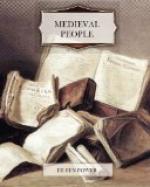I am much beholden to the excellent introductions to these two books, which are models of what editorial introductions should be.
3. The best introduction to the history of the Company of the Staple is to be found in Mr Malden’s aforesaid introduction to The Cely Papers, which also contains a masterly account of the political relations of England, France and Burgundy during the period. I have constantly relied upon Mr Malden’s account of the working of the Staple system. Other useful short accounts of the wool trade and the Stapler’s Company may be found in the following works: Sir C.P. Lucas, The Beginnings of English Overseas Enterprise (1917), c. II; and A.L. Jenckes, The Staple of England (1908).
B. Notes to the Text
1. Four interesting contemporary illustrations of Parliament in 1523, 1585, some date during the seventeenth century, and 1742 respectively, are reproduced in Professor A.F. Pollard’s stimulating study of The Evolution of Parliament (1920).
2. The Lybelle of Englyshe Polycye, in Political Poems and Songs, ed. Thos. Wright (Rolls Ser., 1861), II, p. 162. This remarkable poem was written in 1436 or 1437, in order to exhort the English ’to kepe the see enviroun and namelye the narowe see’ between Dover and Calais, since in the author’s opinion the basis of England’s greatness lay in her trade, for the preservation of which she needed the dominion of the seas. Its chief value lies in the very complete picture which it gives of English import and export trade with the various European countries. There is a convenient edition of it in The Principal Navigations Voyages Traffiques and Discoveries of the English Nation by Richard Hakluyt (Everyman’s Lib. Edition, 1907), I, pp. 174-202.
3. G.W. Morris and L.S. Wood, The Golden Fleece (1922), p. 17.
4. For accounts of these brasses see H. Druitt, A Manual of Costume as Illustrated by Monumental Brasses (1906), pp. 9, 201, 205, 207, 253. John Fortey’s brass and William Greville’s brass are conveniently reproduced in G.W. Morris and L.S. Wood, op. cit., pp. 28, 32, together with several other illustrations, pertinent to the wool trade.
5. Gower, Mirour de l’Omme in The Works of John Gower. I. The French Works, ed. G.C. Macaulay (1899), p. 280-1.
6. The Paston Letters, ed. J. Gairdner (London, 1872-5); Supplement 1901. See also H.S. Bennett, The Pastons and their England (1922).
7. Plumpton Correspondence, ed. T. Stapleton (Camden Soc., 1839).
8. Cely Papers, p. 72; and compare below p. 134.
9. Stonor Letters, II, p. 2.
10. Ibid., II, pp. 2-3.
11. The brasses of his father ‘John Lyndewode, woolman’, and of his brother, also ‘John Lyndewode, woolman’ (d. 1421), are still in Linwood Church. They both have their feet on woolpacks, and on the son’s woolpack is his merchant’s mark. See H. Druitt, op. cit., pp. 204-5.




